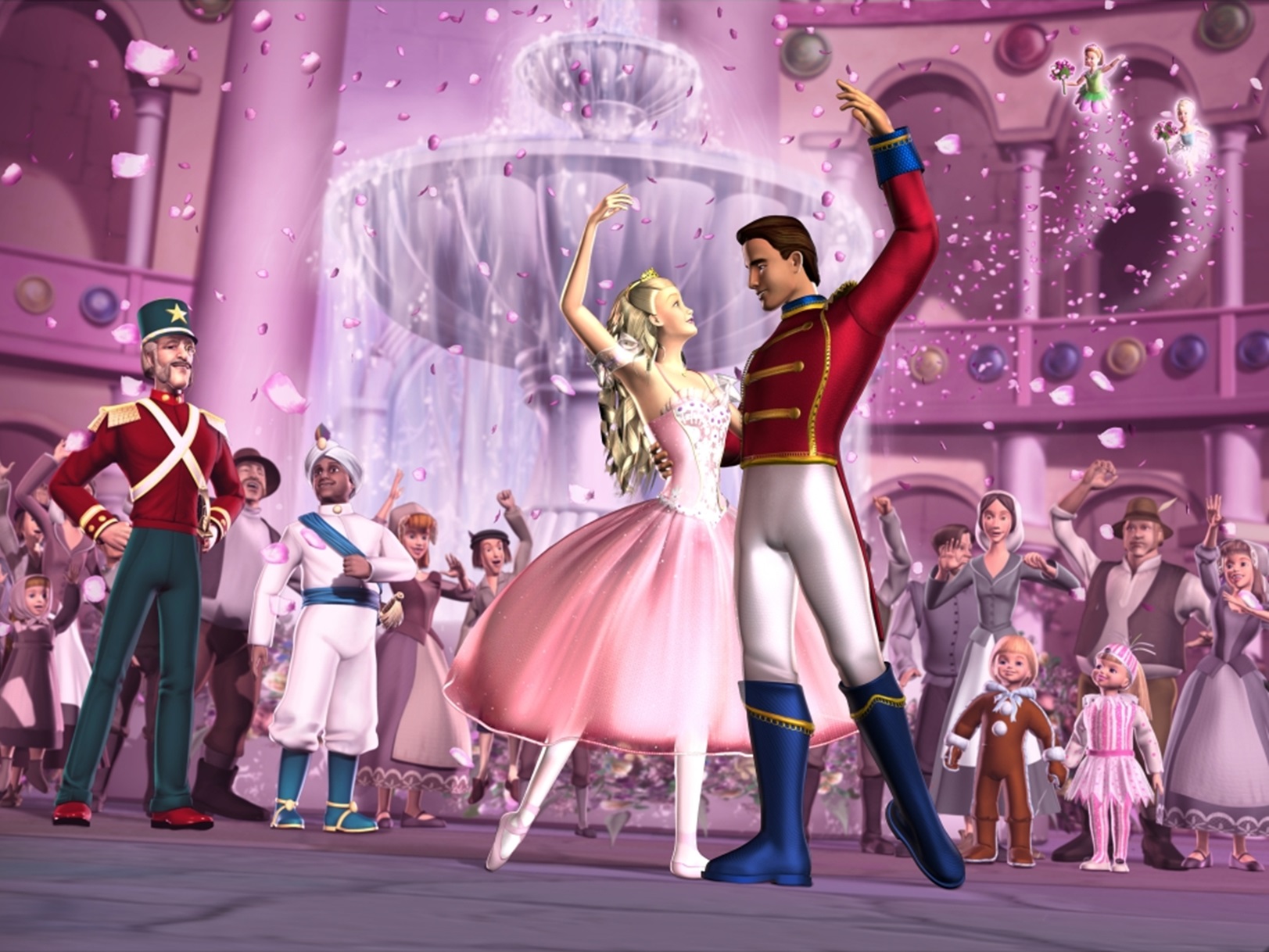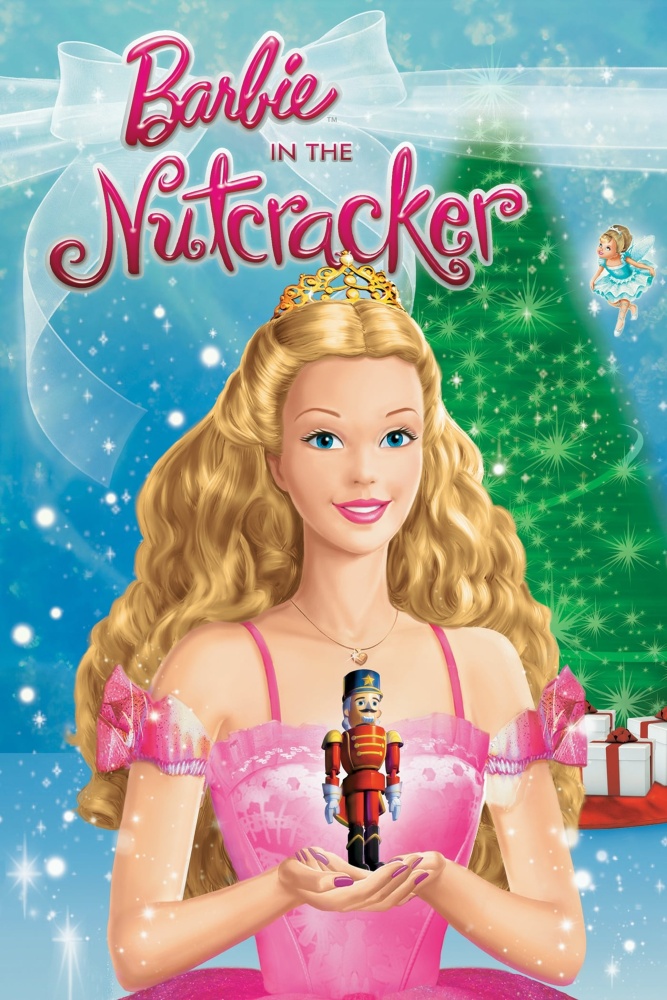Crew
Director – Owen Hurley, Screenplay – Linda Engelsiepen, Hilary Hinkle & Rob Hudnut, Based on the Fairytale by E.T.A. Hoffman, Producers – Jesyca C. Durchin & Jennifer Twiner McCarron, Music – Arnie Roth, Adapted from The Nutcracker Ballet by Pyotr Tchaikovsky, Animation Directors – Michael Ferraro & Gino Nichele, Art Direction – Tony Pulham, Choreography – Peter Martins. Production Company – Mainframe Entertainment/Mattel Entertainment.
Voices
Kelly Sheridan (Clara/Barbie), Kirby Morrow (The Nutcracker/Prince Eric), Tim Curry (Mouse King), Christopher Gaze (Major Mint), Peter Kelamis (Pimm), Ian James Corlett (Captain Candy), Chantal Brand (Kelly), Kathleen Barr (Aunt Elizabeth Drosselmayer), French Tickner (Grandfather Drosselmayer), Britt McKillip (Peppermint Girl), Danny McKinnon (Gingerbread Boy), Alex Doduk (Tommy)
Plot
Barbie is giving ballet lessons to young Kelly. Kelly does not believe she is capable of succeeding and so to inspire her Barbie tells the story of Clara. Clara’s Aunt Elizabeth returned from abroad at Christmas, bringing Clara a toy soldier nutcracker as a present. While Clara slept, The Nutcracker came to life to defend her as the evil Mouse King and his hordes emerged from the wainscoting. When Clara intervened to save The Nutcracker from the mice, the Mouse King cast a spell that shrunk her down to toy size. The Nutcracker took Clara to the land of Parthenia in search of The Sugar Plum Fairy, the only one able to return her to normal size. However, as they travelled through the land, the Mouse King sought to stop them at every opportunity.
Barbie in the Nutcracker was the first of a number of animated films made by Canada’s Mainframe Entertainment featuring Mattel’s famous girl’s doll Barbie. Mainframe (later Rainmaker Entertainment) was the first commercial computer animation company in the world, predating even Pixar. They emerged with tv series such as ReBoot (1994-2001), Beast Wars: Transformers (1996-9), Shadow Raiders (1998-9), Weird-Ohs (1999-2000) and Action Man (2000-1) and then branched out into a number of video/dvd released films. Unlike Pixar, Mainframe appear to have lacked the resources to expand their operation to cinematic success and have spent most of their time in television and video/dvd released films. One of their most lucrative franchises however have been these Barbie films, which consist of Barbie as Rapunzel (2002), Barbie of Swan Lake (2003), Barbie as The Princess and the Pauper (2004), Barbie Fairytopia (2004), Barbie and the Magic of the Pegasus in 3D (2005), Barbie in The 12 Dancing Princesses (2006), Barbie Mermaidia (2006), Barbie as The Island Princess (2007), Barbie Fairytopia: Magic of the Rainbow (2007), Barbie & the Diamond Castle (2008), Barbie in A Christmas Carol (2008), Barbie Mariposa (2008), Barbie and the Three Musketeers (2009), Barbie Presents Thumbelina (2009), Barbie: A Fashion Fairytale (2010), Barbie in a Mermaid Tale (2010), Barbie: A Perfect Christmas (2011), Barbie: A Fairy Secret (2011), Barbie: Princess Charm School (2011), Barbie in a Mermaid Tale 2 (2012), Barbie: The Princess & The Popstar (2012), Barbie and Her Sisters in a Pony Tale (2013), Barbie in The Pink Shoes (2013), Barbie Mariposa and the Fairy Princess (2013), Barbie and the Secret Door (2014), Barbie: The Pearl Princess (2014), Barbie and Her Sisters in the Great Puppy Adventure (2015), Barbie in Princess Power (2015), Barbie in Rock’n’Royals (2015), Barbie and Her Sisters in a Puppy Chase (2016), Barbie Spy Squad (2016), Barbie Star Light Adventures (2016), Barbie: Dolphin Magic (2017) and Barbie: Video Game Hero (2017).
Several of these Barbie films have been adaptations either of classical ballets or fairytales. Barbie usually featured as a character in the present day who is narrating the story to a young girl, whereupon the bulk of the film opens up to a telling of the fairytale, which also featured Barbie as the heroine. This of course became the opportunity to feature Barbie in various costumes and accessories, which Mattel then marketed as part of the Barbie toy line.

Barbie in the Nutcracker is taken from Tchaikovsky’s ballet The Nutcracker (1892), which is in turn based on the fairytale The Nutcracker and The King of Mice (1816) by E.T.A. Hoffman. The ballet has a peculiar lack of plot, which presents some problems to the film. The essence of the original concerns Clara (whose Germanic origin has been excised by the film) who is given a toy soldier Nutcracker as a Christmas present. While Clara dreams beneath the Christmas tree, The Nutcracker comes to life to lead an army of toy soldiers that take on the evil King of Mice, who is finally defeated when Clara throws her shoe at him. She and The Nutcracker dance, he turns into a prince and takes her into the land of the Sugar Plum Fairy. Much fairy dancing ensues, before Clara wakes up under the Christmas tree with The Nutcracker toy in her arms. Mainframe has had to rearrange the story considerably to make it work as a film. In the ballet, the King of Mice is killed in the first act, but the film keeps him alive so as to act as a villain; The Nutcracker turns into the prince early in the second act of the ballet but the film keeps him from doing so until the end; while the venture into the land of the Sugar Plum Fairy has becomes more of a standard fantasy quest, set around the invented McGuffin of Clara desiring to free herself from the Mouse King’s spell and regain her normal size again.
Mainframe’s Barbie films were produced on the cheap and, as always, their characters have a certain blank plasticity and lack the three-dimensional vibrancy that the characters in other computer-animated films (ie. the works of Pixar) do. This certainly improved with the subsequent Barbie films but is less developed here. Barbie in the Nutcracker certainly aspires to an artiness. Mainframe have gone out and filmed dancers from the New York City Ballet and then directly modelled the images of the dancing fairies that appear throughout on them. There is a fluid elegance to the fight scenes, which are all beautifully drawn against lurid firelight.
On the other hand, Barbie in the Nutcracker is also a routine film. Mainframe’s Barbie films tend to be somewhat hackneyed in the story department. The plot here has Barbie go on a journey, return to confront the villain and then banally win the day by the realisation of the magic within herself. The expansion of the plot during the venture into the land of the Sugar Plum Fairy is no more than a series of generic fantasy wilderness encounters – a rock monster, fairies popping up to help Barbie for no apparent reason, a floating rock bridge sitting in the middle of nowhere.


